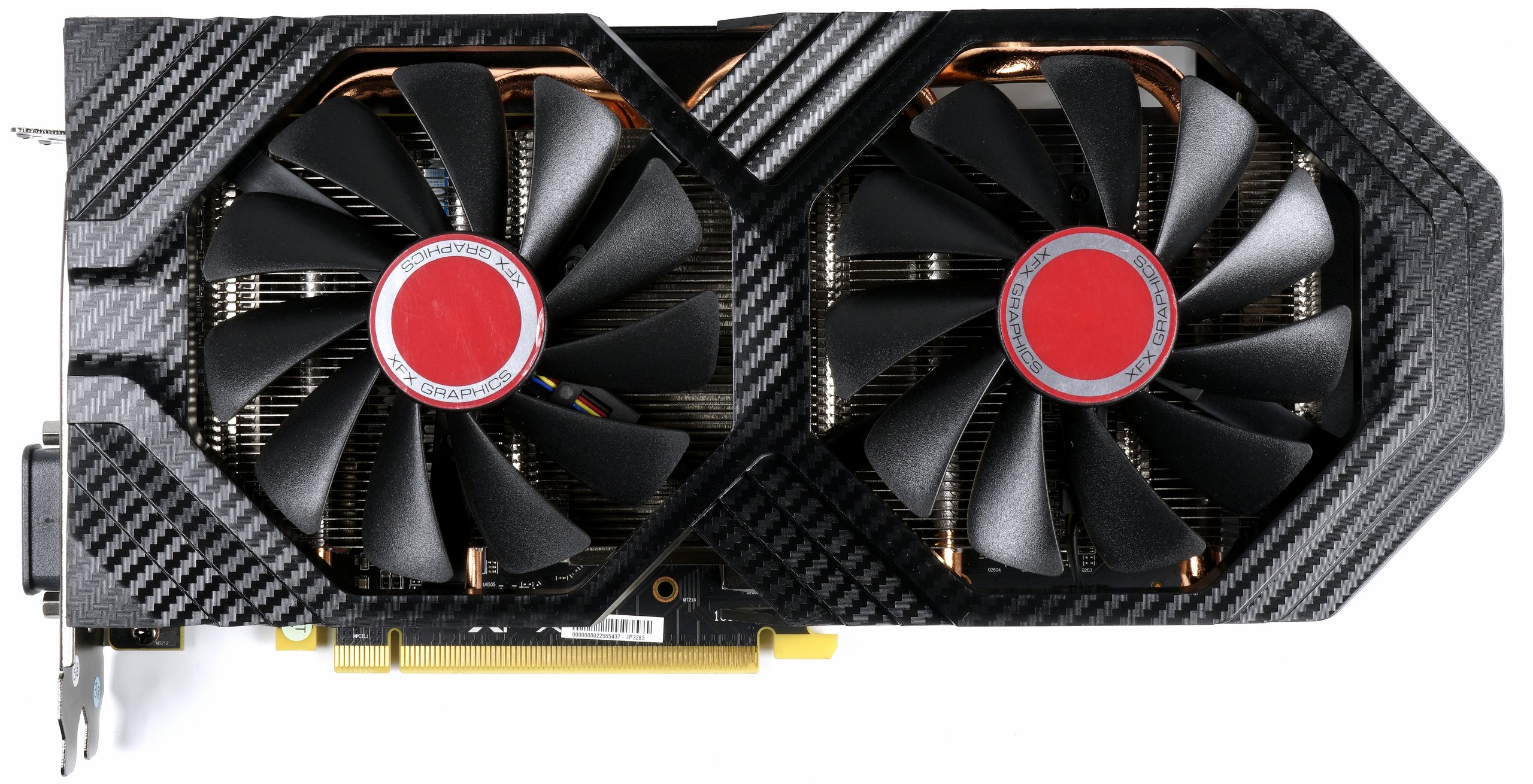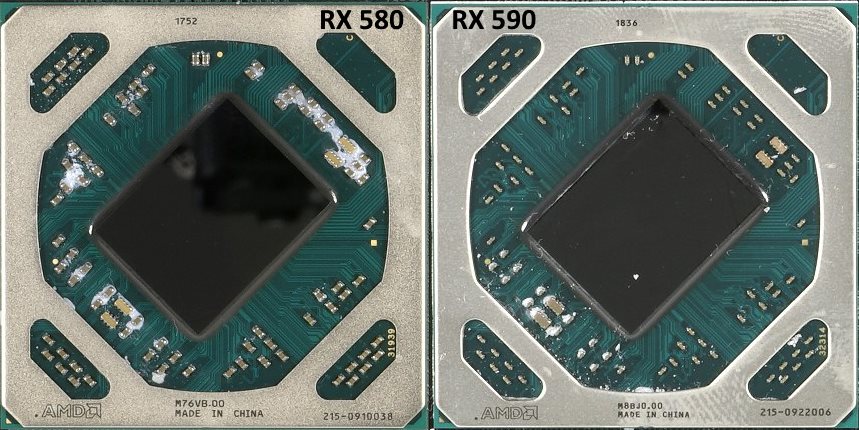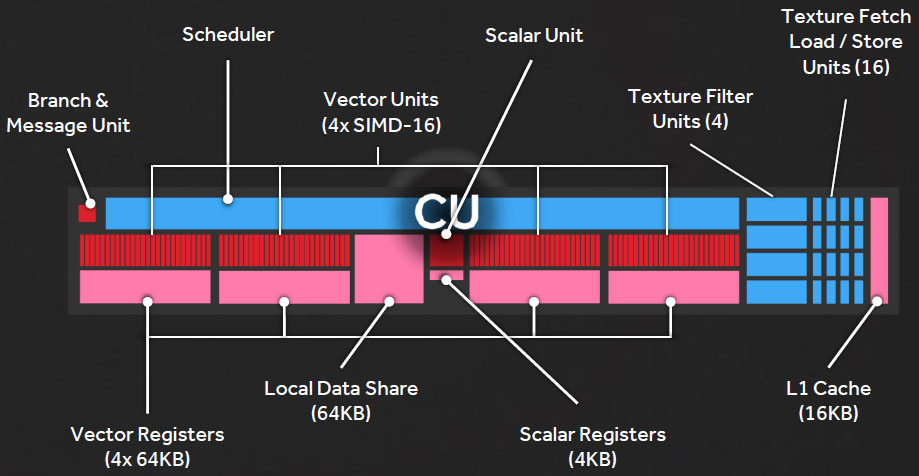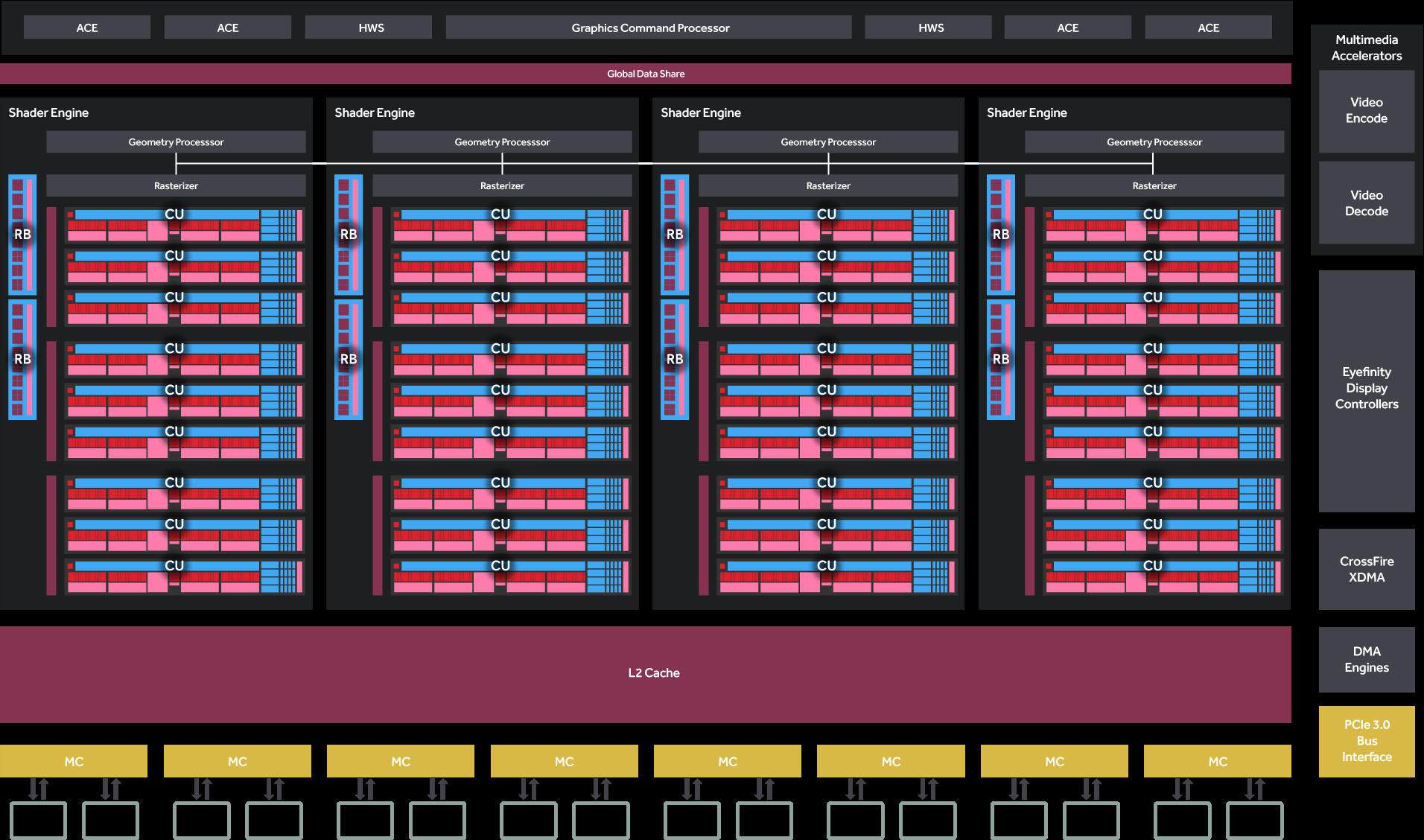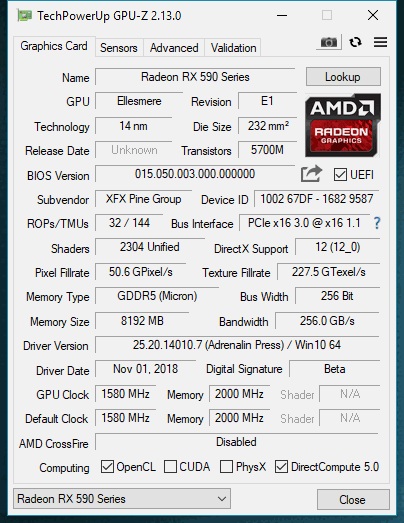Tom's Hardware Verdict
The new Radeon RX 590 beats Nvidia’s GeForce GTX 1060 6GB across our benchmark suite at 1920 x 1080 and 2560 x 1440. However, AMD took a truncheon to the card’s power limit in order to motivate its Polaris GPU. We think you’re better off scooping up great deals on older Radeon RX 580 8GB cards for high-quality gaming at FHD.
Pros
- +
Faster than Radeon RX 580 and GeForce GTX 1060 6GB
- +
Relatively good build quality
- +
Horizontally-oriented fans exhaust some waste heat from your case
- +
Lots of display outputs
Cons
- -
Poor performance/watt
- -
Too expensive compared to Radeon RX 580
- -
Unable to hold rated core clock rate in a closed case
Why you can trust Tom's Hardware
AMD Radeon RX 590 8GB Review
AMD is finally echoing something we’ve been saying for months in our Best Graphics Cards for Gaming column: there’s a gaping hole between Radeon RX 580 and the Radeon RX Vega 56 in its line-up. The company’s Radeon RX 590 8GB is designed to fill that space using its first 12nm mainstream gaming GPU. Although this sounds promising, the new Radeon RX 590 is still based on AMD’s aging fourth-gen Graphics Core Next architecture. It sports the same list of on-board resources as last year’s Radeon RX 580 and 2016’s Radeon RX 480. In other words, all of the 590’s gains come from a higher core clock speed.
Cranking the dial on Polaris’ operating frequency isn’t free, though. Radeon RX 590’s official board power is 225W compared to the older 580’s 185W rating. At least on paper, that’s a 22 percent power consumption increase, enabling a 15 percent overclock, for what AMD claims is an up to 12 percent performance boost. Clearly, we’re at a point of diminishing returns for Polaris’ ability to scale up.
That doesn’t mute the significance of squeezing another couple hundred megahertz out of a mature graphics processor. Back when Radeon RX 480 launched, the chip had a boost specification of 1266 MHz. Today, the XFX Radeon RX 590 Fatboy 8GB OC+ we’re testing boosts up to 1580 MHz—a 25 percent increase from essentially the same chip. The one notable difference is a transition from GlobalFoundries’ 14nm FinFET process to a 12nm FinFET node.
Although AMD explicitly refused to discuss manufacturing beyond its mention of 12nm, CTO Mark Papermaster divulged the company’s plans to shift graphics and client products from 14nm LPP to 12nm LP in 2018 as far back as the GlobalFoundries Technology Conference in September of 2017. Then, in our Ryzen 7 2700X review, we noted that “…AMD's 2000-series CPUs are not manufactured on GlobalFoundries' 14nm LPP node, but rather its 12nm LP process technology. The ported-over design helps boost transistor performance, but does not affect die area or transistor density.”
This is consistent with Radeon RX 590’s Polaris GPU: despite its tweaked process, the official die size remains 232 mm². AMD claims this is to maintain compatibility with third-party motherboard and cooler designs. However, the deeper truth is that reoptimizing for an iterative manufacturing process would be prohibitively expensive, and not worth the potential gains. As such, we're probably seeing GlobalFoundries' 12nm LP process using the same 9T library as 14nm (rather than the new 7.5T library that the foundry says can lower power use by 16 percent at a given frequency).
For now, enthusiasts must be satisfied with a minor manufacturing tweak that enables higher clock rates, overall better performance, but increased power consumption. And with a board power rating of 225W (higher than GeForce RTX 2080), performance per watt metrics won’t be pretty.
AMD is aiming the Radeon RX 590 at budget-minded gamers who missed the boat on add-in cards with 14/16nm GPUs, such as Radeon RX 480 and GeForce GTX 1060. That’d make their graphics subsystems more than two years old, and likely attached to 1920x1080 monitors. The company says cards should start in the $280 (£250) range, representing a $50 increase versus Radeon RX 580 last year. For a purported 12 percent speed up, that 22 percent price premium doesn’t scream value to us. But compared to the $700+ (£300) many Radeon RX 580s were selling for a year ago, $280 (£250) is downright palatable for smooth performance at 1920x1080 and playable frame rates at 2560x1440. What’s more, AMD has a launch bundle that includes Devil May Cry 5, Tom Clancy’s The Division 2 and Resident Evil 2. As far as bundles go, this is one of the better ones we’ve seen, though it’s unique in that none of those games will be available until early 2019.
Get Tom's Hardware's best news and in-depth reviews, straight to your inbox.
| Row 0 - Cell 0 | Radeon RX Vega 56 | Radeon RX 590 | Radeon RX 580 | GeForce GTX 1060 GB |
| GPU | Vega 10 (14nm) | Polaris (12nm) | Polaris (14nm) | GP106 (16nm) |
| Die Size | 486 mm2 | 232 mm2 | 232 mm2 | 200 mm2 |
| Transistors | 12.5 billion | 5.7 billion | 5.7 billion | 4.4 billion |
| Shaders | 3584 | 2304 | 2304 | 1280 |
| Base/Boost Clock Rate | 1156/1471 MHz | 1469/1545 MHz | 1257/1340 MHz | 1506/1709 MHz |
| Peak FP32 Compute | 10.5 TFLOPS | 7.1 TFLOPS | 6.2 TFLOPS | 4.4 TFLOPS |
| Texture Units | 224 | 144 | 144 | 80 |
| Peak Texture Fill Rate | 329.5 GT/s | 222.5 GT/s | 193 GT/s | 136.7 GT/s |
| ROPs | 64 | 32 | 32 | 48 |
| Memory | 8GB HBM2 | 8GB GDDR5 | 8GB GDDR5 | 6GB GDDR5 |
| Memory Bandwidth | 410 GB/s | 256 GB/s | 256 GB/s | 192.1 GB/s |
| TDP | 210W | 225W | 185W | 120W |
The Polaris GPU, Reviewed
At its heart, the XFX Radeon RX 590 Fatboy 8GB OC+ we were sent for review sports some very familiar specifications. Its Polaris GPU contains 36 Compute Units, each CU encompassing 64 IEEE 754-2008-compliant shaders split between four vector units, a scalar unit and 16 texture fetch load/store units. Each CU also hosts four texture units, 16KB of L1 cache, a 64KB local data share, and register space for the vector and scalar units. A number of tweaks made back in 2016 carry over to the Radeon RX 590, yielding up to 15 percent more performance per CU than the Radeon R9 290X’s Hawaii GPU, which was based on a second-gen GCN architecture. Those improvements include the addition of native FP16 (and INT16) support, tuned cache access, and better instruction prefetching.
Nine CUs are organized into a Shader Engine, and Polaris boasts four such SEs, consistent with what we know to be the architecture’s maximum. The math (64 shaders * nine CUs * four SEs) adds up to 2304 Stream processors and 144 texture units.
Each Shader Engine is associated with a Geometry Engine, which AMD improved in the Radeon RX 480 days by adding a primitive discard accelerator for tossing primitives that won't rasterize to a pixel prior to scan conversion, thus increasing throughput. This is an automatic function of the graphics pipeline's pre-rasterization stage. There's also an index cache for instanced geometry, though we're not sure how large this is, or how significant its impact is when instancing is used.
Polaris is capable of up to four primitives per cycle. And of course, this latest iteration of Polaris has a base clock rate of 1469 MHz and a boost rating of 1545 MHz. Those amped-up frequencies compensate for lost on-die resources compared to previous high-end AMD GPUs. Whereas Radeon R9 290X offered 5.6 TFLOPS of single-precision floating-point performance and RX 480 reached up to 5.8 TFLOPS using its boost specification, Radeon RX 590 stretches up to 7.1 TFLOPS. Our XFX Radeon RX 590 Fatboy 8GB OC+ even shipped with a 1580 MHz boost setting, extending peak single-precision performance to 7.3 TFLOPS.
Approaching that theoretical ceiling requires sustaining aggressive clock rates, not hitting them and throttling back. On an open test bench, the Radeon RX 590 maintains its aggressive frequency thanks to cool ambient air. But as we'll see, once the card is buttoned up into a case, it bleeds off much of its advantage over Radeon RX 580.
AMD’s Vega GPU has four render back-ends per Shader Engine, capable of 16 pixels per clock (or 64 across the GPU). Polaris cut that figure in half. Two render back-ends per SE, each with four ROPs, total 32 pixels per clock. To compound matters, Polaris employs a 256-bit memory bus (versus Vega’s 2048-bit HBM2 interface). The 8GB model we’re testing today utilizes 8 Gb/s GDDR5 memory, driving up to 256 GB/s of throughput. That’s a long way from Radeon RX Vega 56’s 410 GB/s.
MORE: Best Graphics Cards
MORE: Desktop GPU Performance Hierarchy Table
MORE: All Graphics Content
Current page: AMD Radeon RX 590 8GB Review
Next Page Meet the XFX Radeon RX 590 Fatboy 8GB OC+-
shrapnel_indie The further cut-down Vega sounds like it could have been a better option to me, primarily if they could make it work with GDDR5, GDDR5X, or GDDR6 memory.Reply -
elbert Wonder if we will see a RX 590X in a month or 2. Higher bin chips passing this overclock and with say GDDR5x 9GB memory.Reply -
v71 A conclusion & a possible editorial mistake:Reply
1. A used GTX 1070 for slightly over $200 is a better value today for 2k gaming.
2. It seems that in GTA V & Metro the slides were mislabled - the 1080p were placed under 2k and viceversa. Look at the presented framerates in those two games & you'll see that 1080p results are worse than 2k;) -
tslot05qsljgo9ed I hope you are joking because this RX 590 is the already the higher bin chips.Reply -
cangelini Reply21488265 said:A conclusion & a possible editorial mistake:
1. A used GTX 1070 for slightly over $200 is a better value today for 2k gaming.
2. It seems that in GTA V & Metro the slides were mislabled - the 1080p were placed under 2k and viceversa. Look at the presented framerates in those two games & you'll see that 1080p results are worse than 2k;)
Good eye! :)
The perf difference is actually from turning off SSAA at 2560x1440 in Metro and disabling 4xAA at 2560x1440 in GTAV as we try to keep QHD a playable resolution. Maintaining the same quality settings would have hit that res too hard. -
mohit9206 238W of power while gaming? That is unacceptable. 7nm cards can't come soon enough for AMD.Reply -
hannibal Reply21488220 said:The further cut-down Vega sounds like it could have been a better option to me, primarily if they could make it work with GDDR5, GDDR5X, or GDDR6 memory.
Yep, but that would require complete remaking that chip. Well Hopefully good Ryzen selling Numbers give money Also to gpu department so that They can afford to completely rehaul their low end and middle range cards. Even this 12nm with that 7.5 library would offer good gains if paineen with refress in architecture. But that remain to later timeframe. New card will require a couple of years, so if and because the company is in right track, one or two years From now there will be improvements if They start now the developmening it. -
mohit9206 Quote from anandtech reviewReply
"Once again though, we've observed that VRAM is never enough. It was only a few years ago that 8GB of VRAM was considered excessive, only useful for 4K. But especially with the popularity of HD texture packs, even 6GB of framebuffer could prove limiting at 1080p with graphically demanding games. In that respect, the RX 590's 8GB keeps it covered but also brings additional horsepower over the 8GB R9 390. For memoryhogging games like Shadow of War, Wolfenstein II, or now Far Cry 5 (with HD textures), the 8GBs go a long way. Even at 1080p, GTX 980/970 performance in Wolfenstein II tanks because of the lack of framebuffer. For those looking to upgrade from 2GB or 4GB cards, both the RX 580 and RX 590 should be of interest."
So as you can see 480/580 and 590 do benefit from the extra vram even at 1080p. I do feel all those people who asked on various forums on whether to buy 4gb or 8gb and got recommended 4gb since they were playing at 1080p were wronged as just a year or two later games are now benefitting from larger than 4gb framebuffer. Now those people will have to upgrade their cards sooner rather than if they had 8gb model they would have been able to keep the card longer.The forums can sometimes give wrong advice to people and screw them over. -
AgentLozen AMD got some awful diminishing returns from overclocking a 580. I wonder if we would see better returns if they reconfigured the cores and ROPs instead of using a 580 as the foundation.Reply
I'm disappointed with the 14nm -> 12nm transition. It seems like it did nothing to help with power consumption or heat. I was hopeful because it was helpful in regards to AMD's Ryzen chips.
